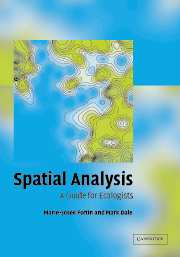Book contents
3 - Spatial analysis of sample data
Published online by Cambridge University Press: 29 July 2009
Summary
Introduction
Chapter 2 presented the spatial methods used to analyse patterns generated by point pattern processes, i.e. point pattern methods. Point pattern processes generate a spatial distribution of events, which can then be analysed for their spatial pattern. The x−y coordinates of all events (e.g. individuals, objects, entities) in a given study area are required for analysis. In ecological studies, a number of point pattern processes take place, one of the most common being seed or spore dispersal. There are, however, several other types of ecological and environmental data that are not discrete, like individual trees, but rather are continuous, like soil moisture. The processes that generate such continuous variables are called surface pattern processes and the spatial statistics that analyse them are called ‘surface pattern’ methods or ‘area pattern’ methods. There are, however, grey zones between point pattern and surface pattern analyses, as when point pattern data are transformed into surface pattern data by summarizing the number of events per sampling unit as density. In doing so, point data are converted into quantitative data such that surface pattern methods can be used to analyse their spatial structure. When the entire study area is surveyed using contiguous sampling units, these quantitative data represent the entire population of data in the study area and can be analysed using the spatial methods for contiguous sample unit data presented in Chapter 2.
Information
- Type
- Chapter
- Information
- Spatial AnalysisA Guide for Ecologists, pp. 111 - 173Publisher: Cambridge University PressPrint publication year: 2005
Accessibility standard: Unknown
Why this information is here
This section outlines the accessibility features of this content - including support for screen readers, full keyboard navigation and high-contrast display options. This may not be relevant for you.Accessibility Information
- 2
- Cited by
